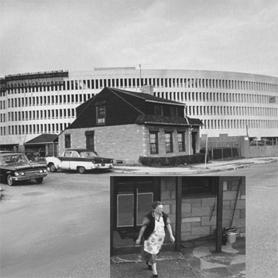In 1963, Macy's Department Store decided to build a branch in Queens, N.Y., began to buy up all the property on a prime five-acre site. As quickly as anyone could say money, everyone had sold out — except for Mary Sondek, an elderly mother of six, who lived in a two-story gingerbread house on a 170-ft. by 50-ft. corner plot. Assuming that she was simply waiting until the price was right, Macy's went ahead with plans for a circular stadium-sized store whose perimeter would cut a small corner off the far end of the widow's backyard. Not even $200,000 could budge Mrs. Sondek, and today the store stands just months away from completion with a 5-ft.-deep, 21-ft.-wide notch in its otherwise unbroken facade. The notch not only cost Macy's an extra $50,000 in building costs, but also some 15 parking spaces (the outside ring of the building consists of five parking ramps).
Hidden Bargains. For whatever motives, “holdouts” have often stopped a bulldozer in its tracks. Some simply are waiting to see how high the developer will go. Others, like Mrs. Sondek, hang on to their land with the tenacity of Barbara Frietchies for their own very special reasons (Mrs. Sondek claimed that she needed every inch of the plot for her dog).
If any store needed to be reminded of the redoubtable stubbornness of holdouts, it should not have been Macy's. Over 60 years ago, Macy's had to design its mammoth store in downtown Manhattan to avoid a tiny, five-story building whose owners refused to sell for less than $375,000. Today the ground floor of that building shelters a hot-dog emporium (reputed to be the city's most profitable), and the other floors are hidden behind a huge bill board, which reads “This Is Macy's —The World's Largest Store.” Macy's leases it for one of the world's fanciest billboard prices.
Across the U.S., virtually every city and suburb can point with pride—and sometimes alarm—at those who forced Progress to step around them rather than let it walk over them. For most holdouts, there may be satisfaction in the fact that they automatically produce a monument to their own stubbornness. The symmetry of Manhattan's towering RCA Building is notched by a drab four-story building housing Hurley's Bar, whose owner turned down offers of $1,000,000. San Francisco's 27-story Shell Building is conspicuously shaped to surround a narrow, eleven-story building whose owner refused to sell.
In holdout lore, a classic is another San Francisco case. The holdout owned a four-story building at Kearny and Geary streets. Developers assembled sites on either side of him, proposed to build an eight-story office building on the corner. The holdout held out too long, and the developers simply built their buildings around him. Outraged at losing a bundle, he built two concrete “spite walls” four stories up from the top of his own building, shutting off virtually all the window exposure of his two tall neighbors.
Barbara or Bill? In Chicago, there is the celebrated case of the owner of a hardware store on Lake Street, who refused to make way for a 14-story building. The contractor built around the store, making provisions to bridge the gap later. As the building rose, nail kegs began to drop “accidentally” from the scaffolding onto the hardware-store roof. After a few weeks of this treatment, the owner finally rushed out shouting “Take it! Take it!”
Shrewd real estate operators no longer even try to bribe or threaten holdouts —instead, they join their ranks. More and more frequently, when a developer commits himself to build a shiny new tower, he takes the precaution of buying a small lot in the middle of surrounding blocks. Thus, if another builder tries to buy up the whole block to put up a building tall enough to block the tower's light and view, he can use his small lot as a bargaining lever to make a rival builder move elsewhere or design his structure in such a way as to keep the sun shining through the tower's windows. It is even getting hard to tell whether holdouts who seem to be Barbara Frietchies are not, in fact, Bill Zeckendorfs in disguise.
© 2020 The Juniper Park Civic Association Inc. All Rights Reserved.
SERVING MIDDLE VILLAGE AND MASPETH SINCE 1938.




